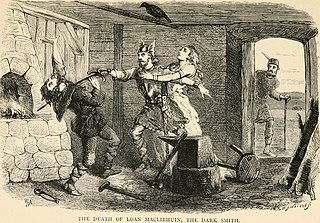Related Research Articles
Pope Leo IV was the bishop of Rome and ruler of the Papal States from 10 April 847 to his death. He is remembered for repairing Roman churches that had been damaged during the Arab raid against Rome, and for building the Leonine Wall around Vatican Hill to protect the city. Pope Leo organized a league of Italian cities who fought and won the sea Battle of Ostia against the Saracens.

Pitsmoor is a former village, now a suburb of Sheffield, England. The name derives from Or-pits as, anciently, the main local industry was the mining of ore. The village falls within the Burngreave ward of the City.

Parading on a donkey is a traditional psychological punishment, consisting in a public humiliation.

Whiteinch is an area in the city of Glasgow, Scotland. It is situated directly north of the River Clyde, between the Partick and Scotstoun areas of the city. Whiteinch was at one stage part of the burgh of Partick, until that burgh's absorption into the expanding city of Glasgow in 1912, and part of the Parish of Govan.

William Edward Armytage Axon was an English librarian, antiquary and journalist for the Manchester Guardian. He contributed to the Dictionary of National Biography under his initials W. E. A. A. He was also a notable vegetarianism activist.

Edward Walford (1823–1897) was an English magazine editor and a compiler of educational, biographical, genealogical and touristic works, perhaps best known for the final four volumes of Old and New London.

Dūdmaišis or Labonoro dūda is a Lithuanian bagpipe with a single chanter and drone. The Lithuanian bagpipe was traditionally played at a variety of events, including May Day festivities, and spring caroling. A 1955 publication by the Lituanus Foundation noted that: "The Labanoro Dūda or Bagpipe was at one time very widely used, though it is almost forgotten."

Hildenley is a former civil parish, now in the parish of Amotherby, 2 miles (3.2 km) south-west of Malton, North Yorkshire, England, on the north bank of the River Derwent. In 1971 the parish had a population of 27. Hildenley stone, considered to be the best decorative stone in Yorkshire, takes its name from the site. Until 1974 it was in the North Riding of Yorkshire. From 1974 to 2023 it was in Ryedale district.
Ballylough Castle is a ruined castle in County Antrim, Northern Ireland, that was a stronghold of the MacQuillans and the MacDonnells in former times.

St Cuthbert's Church is located in Elsdon, Alnwick, northeast England. The church was one of the resting places of St. Cuthbert's body in the wanderings of the monks. It is one of the many dedicated to his memory. St Cuthbert's Church is a Grade I listed building in Northumberland.
Pegasides were nymphs of Greek mythology connected with wells and springs, specifically those that the mythical horse Pegasus created by striking the ground with his hooves.

Loan Maclibuin was a legendary Norwegian smith. He was known as "The Dark Smith of Drontheim". He was the seventh son of Windy Cap, King of Norway. The "dark", does not refer to his working black magic, but rather to his swarthy nature.
George Latimer Apperson ISO, (1857–1937) was a school inspector and man of letters.

Sir John Hill of Kytton in the parish of Holcombe Rogus, and of Hill's Court in the parish of St Sidwell in the City of Exeter, both in Devon, was a Justice of the King's Bench from 1389 to 1408. He sat in Parliament for a number of Devon boroughs between 1360 and 1380.
William de Boderisham was an English Dominican theologian who served as Master of the Sacred Apostolic Palace in the 14th century. He was appointed by Pope Urban IV in 1263.

The Rhos-Rydd Shield, or Rhyd y Gors is a large copper-alloy Yetholm-type shield from the Bronze Age, found in Rhos-Rydd or Rhyd y Gors, near Blaenplwyf, Wales. It is currently held in the British Museum in London. It is completely flat, 667 mm across, and 0.7 mm thick, weighing 1929 grams. It dates from the 12th to the 10th century BC.

The Moel Hebog shield or Moel Siabod shield is a large copper-alloy Yetholm-type shield from Bronze Age Britain, found in Wales in 1784, and is now in the British Museum in London. It dates from 1300–1000 BC.
Frederick Lawrence Tavaré was an English landscape painter and antiquarian.
Aelia Sabina was a musician who primarily played the hydraulis, an early version of the organ. She lived in Roman settlement of Aquincum, located in modern-day Budapest, Hungary.

Croyland and Swanspool is a ward and suburb of Wellingborough in Northamptonshire, England. It had a population of 14,477 at the 2021 Census.
References
- ↑ "Literary". The Cornishman. No. 67. 23 October 1879. p. 6.
- ↑ Harvard library catalog
- ↑ Encyclopædia Britannica, 11th ed. (1910), vol. 7, p. xii. Fallow was also the author of Memorials of Old Yorkshire and The Cathedral Churches of Ireland.
- ↑ Lynda Mugglestone, Lexicography and the OED, 2000, ISBN 0198237847, p. 233